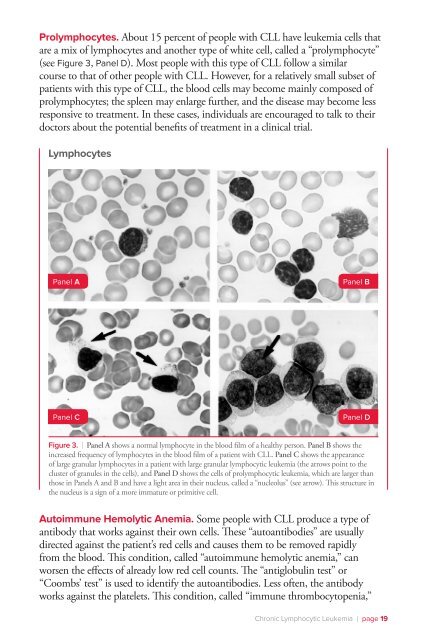Chronic Lymphocytic Leukemia - The Leukemia & Lymphoma Society
Chronic Lymphocytic Leukemia - The Leukemia & Lymphoma Society
Chronic Lymphocytic Leukemia - The Leukemia & Lymphoma Society
You also want an ePaper? Increase the reach of your titles
YUMPU automatically turns print PDFs into web optimized ePapers that Google loves.
Prolymphocytes. About 15 percent of people with CLL have leukemia cells that<br />
are a mix of lymphocytes and another type of white cell, called a “prolymphocyte”<br />
(see Figure 3, Panel D). Most people with this type of CLL follow a similar<br />
course to that of other people with CLL. However, for a relatively small subset of<br />
patients with this type of CLL, the blood cells may become mainly composed of<br />
prolymphocytes; the spleen may enlarge further, and the disease may become less<br />
responsive to treatment. In these cases, individuals are encouraged to talk to their<br />
doctors about the potential benefits of treatment in a clinical trial.<br />
Lymphocytes<br />
Panel A Panel B<br />
Panel C<br />
Panel D<br />
Figure 3. I Panel A shows a normal lymphocyte in the blood film of a healthy person. Panel B shows the<br />
increased frequency of lymphocytes in the blood film of a patient with CLL. Panel C shows the appearance<br />
of large granular lymphocytes in a patient with large granular lymphocytic leukemia (the arrows point to the<br />
cluster of granules in the cells), and Panel D shows the cells of prolymphocytic leukemia, which are larger than<br />
those in Panels A and B and have a light area in their nucleus, called a “nucleolus” (see arrow). This structure in<br />
the nucleus is a sign of a more immature or primitive cell.<br />
Autoimmune Hemolytic Anemia. Some people with CLL produce a type of<br />
antibody that works against their own cells. <strong>The</strong>se “autoantibodies” are usually<br />
directed against the patient’s red cells and causes them to be removed rapidly<br />
from the blood. This condition, called “autoimmune hemolytic anemia,” can<br />
worsen the effects of already low red cell counts. <strong>The</strong> “antiglobulin test” or<br />
“Coombs’ test” is used to identify the autoantibodies. Less often, the antibody<br />
works against the platelets. This condition, called “immune thrombocytopenia,”<br />
<strong>Chronic</strong> <strong>Lymphocytic</strong> <strong>Leukemia</strong> I page 19

















